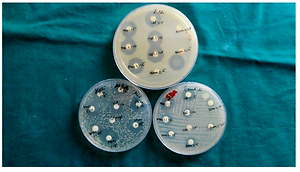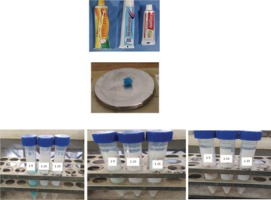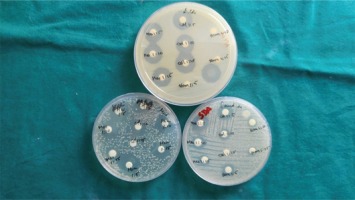INTRODUCTION
Globally, dental caries and gingivitis are the most common oral diseases that affect people of all ages1. The occurrence of dental caries is approximately 60–65% among the Indian population2,3. Dental diseases are primarily caused by the virulence of complex oral micro-communities4. Dental plaque micro-organisms degrade the dietary carbohydrates and produce lactic acid, which leads to localized demineralization and dental caries, eventually5,6.
Poor oral hygiene is the major risk factor for the accumulation of microbes and their harmful activities4,7. Most of the dental diseases can be prevented from occurring by the simple practice of personal hygiene habits8,9. Besides mechanical cleansing of teeth, the use of chemical agents has been proposed as an effective method of reducing plaquemediated disease10. Most effective among them is the tooth brushing habit as the antibacterial efficacy of the toothpaste has a major role to play in the outcome11,12.
Triclosan, an antibacterial agent, which is a common ingredient in toothpaste, helps to prevent gingivitis by reducing calculus formation13. Herbal products contain antimicrobial agents and may be more appealing as they do not require alcohol, preservatives, and flavours, for their activity14,15. The basic homeopathic principle is that a substance in fewer doses efficiently cures those similar symptoms that would require a larger dose. It has been proven that the homeopathic formulations are non-toxic, antiinflammatory, and antimicrobial16. Considering the availability of abundant brands of toothpaste in the market, their efficacy to control the bacterial count has to be monitored and analysed scientifically. Currently, the increased popularity of herbal products has mandated that dental professionals evaluate the effectiveness of these products in the prevention of oral ailments and provide evidence-based suggestions to their patients for making a better choice17. Also, there is a growing interest around the world to study the benefits of various medicinal plants, over the last decade18.
Antibiotic susceptibility testing is the method employed for testing the effectiveness of agents against specific microorganisms19. Disk diffusion assay offers many advantages such as simplicity, low cost, ability to test large numbers of microorganisms and antimicrobial agents, and the ease to interpret results19. Hence, this study aims to compare the efficacy of herbal, homeopathic, and conventional dentifrices, on oral microflora using antibiotic susceptibility tests.
METHODS
For the present in vitro study, three strains of micro-organisms, Streptococcus Mutans, Escherichia Coli, and Candida Albicans, were considered. The media used were Mutans media, Mueller Hilton agar, and Sabouraud Dextrose agar, respectively, for each micro-organism. We prepared dilutions of several brands of commercial toothpaste with different compositions. Double distilled water, pyrogen-free water, test tubes, Petri plates, micropipettes, and gel puncher were the other materials utilized for the study.
Solutions of selected dentifrices were made by mixing 1 g of dentifrices in 4 mL of distilled water to give 1:5 dilutions, in a sterile container. Further dilutions were made by mixing 1 g of toothpaste with 9 mL and 14 mL to give 1:10 and 1:15 dilutions, respectively (Figure 1).
Three strains of microorganisms, S. Mutans, E. Coli, and C. Albicans, were grown in Mutans media, Mueller Hilton agar, and Sabouraud Dextrose agar media, respectively. These bacteria were inoculated in their respective medium by the swab method (Figure 2).
Sterile disks were incorporated with an equal amount of different dilutions of prepared toothpaste formulations using a micropipette. These disks were then placed equidistant to each other and the plates were incubated for 24 hours. The zones of inhibition were measured to the nearest whole mm using a graduated ruler by holding the test plates in front of a desk lamp.
Ethical clearance was obtained from the institutional ethical committee before beginning the study.
RESULTS
Zone of inhibition against S. Mutans was found to be higher in homeopathic dentifrice followed by herbal dentifrice, and the least by conventional dentifrice, and no inhibition at 1:5, 1:10 and 1:15 dilutions, respectively (Table 1). Zone of inhibition against C. Albicans was found to be higher in herbal dentifrice followed by conventional dentifrice, and no inhibition, and the least by homeopathic dentifrice at 1:5, 1:10 and 1:15 dilutions, respectively. Zone of inhibition against E. Coli was found to be higher in herbal dentifrice followed by conventional dentifrice, and no inhibition by homeopathic dentifrice at 1:5, 1:10 and 1:15 dilutions, respectively.
Table 1
Zone of inhibition (mm) of various types of dentifrices at three dilutions
DISCUSSION
Microbial biofilms are the major causative factors of caries and periodontal disease, and it is of utmost importance to control these biofilms by mechanical and chemical debridement15. Prevalence of dentinal caries result from poor oral hygiene. It has been proven scientifically that maintaining good oral hygiene is the key to preventing dental diseases4. Toothpaste is a gel dentifrice used with a toothbrush accessory to clean and maintain oral hygiene.
There is a paucity of literature about the efficacy of different types of dentifrices against oral microorganisms. Hence, this study was conducted to test the antimicrobial efficacy of three different dentifrices (herbal, homeopathic, and conventional fluoride containing) against S. Mutans, E. Coli, and C. Albicans.
Three different dentifrice formulations 1:5, 1:10, and 1:15, were made by mixing distilled water with dentifrice. The media used were Mutans media, Mueller Hilton agar, and Sabouraud Dextrose agar media, respectively, for each microorganism by swab method. The antimicrobial efficacy was then tested using the disk diffusion method.
In this study, the antimicrobial efficacy of dentifrice formulations against S. Mutans was measured as a zone of inhibition. The zone of inhibition is found to be higher in homeopathic dentifrice 24 mm, 19 mm, and 20 mm, followed by herbal dentifrice 19 mm, 17 mm, and 13 mm, and the least by conventional dentifrice 17 mm, 15 mm, and no inhibition, at 1:5, 1:10 and 1:15 dilutions, respectively. Similar results were obtained in the study conducted by Mohankumar et al.17 where herbal toothpaste was found to have similar antibacterial activity compared to the conventional toothpaste. The herbal toothpaste with a combination of different varieties of herbs has better antimicrobial activity compared to those with a single ingredient. However, studies conducted by Anushree et al.14 and Prasanth3 showed fluoride and triclosan containing dentifrices had higher zones of inhibition at higher dilutions. Homeopathic-based dentifrices showed antimicrobial efficacy against S. Mutans since the major ingredients of its formulations were kreosotum, Plantago major, and calendula14.
Similar results were observed by Gibraiel et al.12 in their study where the toothpaste having natural formulation had given maximum zones of inhibition against E. Coli at 1:1 dilution. However, studies conducted by Anushree et al.14 and Prasanth3 showed fluoride and triclosan containing dentifrices had higher zones of inhibition at higher dilutions. The difference in the result may be attributed to the active ingredient used in the herbal dentifrices. However, studies conducted by Anushree et al.14 and Prasanth3 showed fluoride and triclosan containing dentifrices had higher zones of inhibition at higher dilutions. This difference may be because different herbal products exhibit different levels of antimicrobial activity.
Herbal dentifrice showed an increased antimicrobial activity than homeopathic and conventional dentifrices, against all the test organisms. It is thus necessary to acquire and preserve this traditional system of medicine by proper documentation. Further, in vivo studies have to be conducted to assess the antimicrobial effectiveness of these dentifrices.
CONCLUSIONS
The results of the present study show that toothpaste formulations containing homeopathic and natural antimicrobial agents were more effective in controlling oral microflora compared to conventional toothpaste. This provides insight to the dentists that homeopathic and herbal dentifrices are effective in controlling microorganisms related to major oral diseases and can be advised to the patients.




